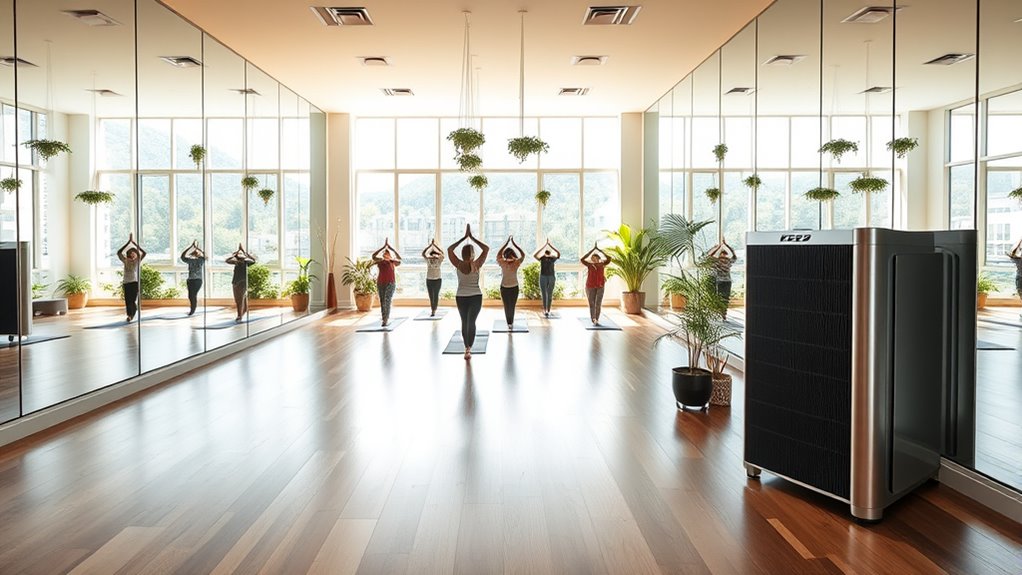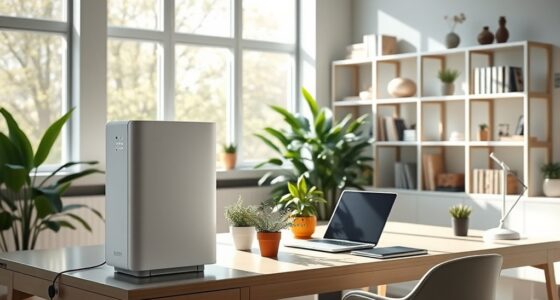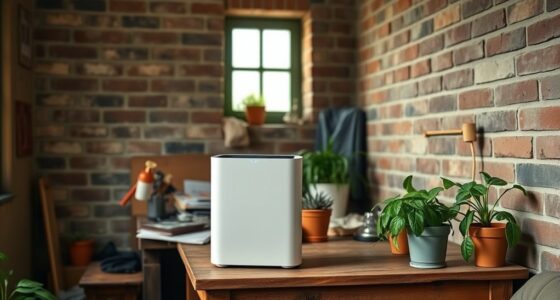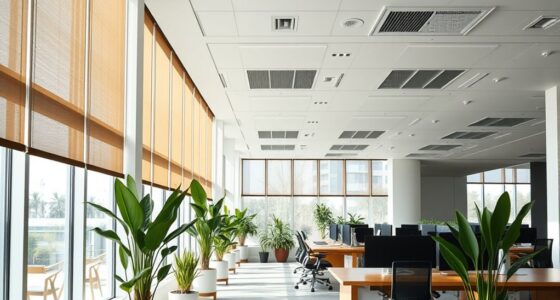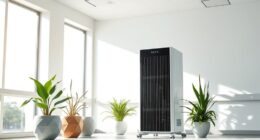To guarantee a healthy environment in your fitness studio or yoga center, combine proper ventilation with ozone purification. Ventilation helps replace stale air with fresh outdoor air and controls humidity, while ozone machines effectively neutralize odors, bacteria, and viruses. Together, these strategies keep air clean, safe, and inviting for clients. If you’re interested, you’ll find more effective ways to maintain ideal air quality that benefits everyone who walks through your doors.
Key Takeaways
- Implement proper ventilation systems, including HVAC with high-efficiency filters, to exchange stale air with fresh outdoor air.
- Use ozone purification to effectively neutralize bacteria, viruses, and odors, ensuring a cleaner indoor environment.
- Monitor air quality with sensors to optimize airflow, humidity, and pollutant removal in real-time.
- Maintain regular cleaning and humidity control to prevent mold growth and bacterial proliferation.
- Combine ventilation and ozone treatments for comprehensive air purification, enhancing safety and overall exercise experience.

Have you ever wondered how clean the air is during your workout or yoga session? The quality of the air you breathe can considerably impact your health, focus, and overall experience. Fitness studios and yoga centers often see high foot traffic, which means more sweat, breath, and potential airborne contaminants. That’s why implementing effective air purification methods is essential. Two key strategies to consider are ventilation strategies and ozone purification. These approaches work together to guarantee you’re breathing fresh, clean air while you exercise.
Ventilation strategies involve the careful management of air exchange within your space. It’s not just about opening windows; it’s about designing a system that consistently replaces stale air with fresh outdoor air. Proper ventilation reduces carbon dioxide buildup, minimizes odors, and limits the accumulation of airborne pathogens. In a busy fitness or yoga studio, you want to maximize airflow without causing drafts or discomfort. Mechanical ventilation systems, such as HVAC units equipped with high-efficiency filters, can help maintain a steady flow of clean air. These systems can also be integrated with sensors that monitor air quality, adjusting airflow as needed to maintain ideal conditions. Effective ventilation also helps control humidity levels, which is essential because high humidity can promote mold growth and bacteria proliferation, both of which compromise air quality. Incorporating air filtration technology can further enhance the removal of airborne particles and pathogens.
Ozone purification adds another layer of protection by actively neutralizing pollutants. Ozone generators produce ozone molecules that react with and break down airborne contaminants like bacteria, viruses, and odors. When used correctly, ozone purification can greatly enhance air quality, especially in spaces with high occupancy or lingering odors. It’s important, however, to use ozone generators responsibly, as excessive ozone can be harmful to health. Professional installation and operation ensure that ozone levels stay within safe limits while maximizing purification benefits. This technology is particularly effective at eliminating stubborn smells and disinfecting the air, making your studio a healthier environment for everyone.
Combining ventilation strategies with ozone purification creates a comprehensive approach to air quality management. While ventilation ensures a continuous supply of fresh air and removal of stale air, ozone purification targets lingering pollutants and pathogens. Together, they help create a clean, safe space that supports your health and enhances your workout or yoga experience. If you’re committed to maintaining a healthy environment, investing in these strategies is a wise move. Not only will you breathe easier, but you’ll also promote a safer, more inviting atmosphere for all your clients and practitioners.
Frequently Asked Questions
How Often Should Air Purifiers Be Replaced in Fitness Centers?
You should replace your air filters every 6 to 12 months, depending on the air filter lifespan and usage. Regular maintenance frequency, like checking filters monthly, helps guarantee ideal air quality. If your fitness center has high foot traffic or heavy equipment use, consider replacing filters more often. Properly maintained filters keep the air clean, support healthier environments, and prevent strain on your air purifiers.
Are There Specific Air Purification Systems Recommended for Yoga Studios?
Yes, for your yoga studio, consider air purification systems with HEPA filters and UV-C technology to improve airflow and create a breathable environment. These systems effectively remove airborne pollutants and pathogens, enhancing the overall comfort and safety for your clients. Make sure the purifier suits your studio’s size, ensuring consistent airflow and ideal purification, so your space remains fresh, clean, and welcoming during every session.
How Does Air Purification Impact COVID-19 Transmission in Fitness Spaces?
Air purification dramatically reduces virus transmission in fitness spaces by targeting aerosol particles that carry COVID-19. By actively filtering and reducing aerosols, these systems can make your environment safer and healthier. It’s like having a superhero fighting invisible enemies, preventing the spread of the virus. You’ll breathe easier knowing that your space minimizes aerosol transmission, helping protect everyone and making your fitness environment safer for all.
What Is the Cost Difference Between Various Air Purification Technologies?
The cost comparison between air purification technologies varies widely. HEPA filters tend to be more affordable upfront but require regular replacement, while UV-C and ionization systems have higher initial costs but lower ongoing expenses. You’ll find that technology affordability depends on your budget and needs. Generally, simpler filtration systems are more budget-friendly, but investing in advanced tech offers better long-term air quality. Consider your space and budget to choose the best fit.
Can Air Purifiers Help Reduce Outdoor Pollution Effects Indoors?
Yes, air purifiers can help reduce outdoor pollution effects indoors. They improve indoor allergen control, filter out harmful particles, and enhance overall air quality. By continuously monitoring air quality, you guarantee the purifier works effectively. Using air purifiers, you actively combat outdoor pollutants, protect your indoor environment, and create a healthier space. This proactive approach keeps air cleaner, fresher, and safer for everyone inside your home or workspace.
Conclusion
By choosing the right air purification, you’re planting the seeds for a healthier, more vibrant space—your sanctuary of strength and serenity. Just as a gust of fresh air revitalizes your body and mind, clean air symbolizes renewal and balance. When you prioritize purity, you’re nurturing a haven where every inhale fuels your journey toward wellness. Let your studio be a lighthouse of freshness, guiding every soul toward clarity, calm, and renewed energy.
